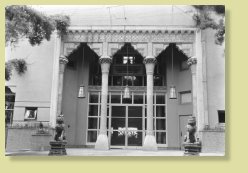 |
Robbins-Mills Collection of Herbert Wendell Gleason Photographic Negatives, 1899-1937 Concord Free Public Library — Special Collections |
Series V – Homes and Gardens of Massachusetts, Rhode Island, Maine, Connecticut, New York, and New Jersey, 1923-1937
 Series V (85 glass, 1,228 film) is organized into six subseries by state. Each subseries is arranged by town in alphabetical order and by date. It is the largest series in the collection and profiles many prominent homes and gardens including the formal estates of Massachusetts, Newport, RI, and Long Island, NY in the 1920s and 1930s. Gleason's later work as a photographer for the Arnold Arboretum (during the 1930s) and his involvement with New England horticultural shows (including the Massachusetts Horticultural Society and various garden clubs) brought him into contact with the owners of many of the private gardens photographed in this series.
Series V (85 glass, 1,228 film) is organized into six subseries by state. Each subseries is arranged by town in alphabetical order and by date. It is the largest series in the collection and profiles many prominent homes and gardens including the formal estates of Massachusetts, Newport, RI, and Long Island, NY in the 1920s and 1930s. Gleason's later work as a photographer for the Arnold Arboretum (during the 1930s) and his involvement with New England horticultural shows (including the Massachusetts Horticultural Society and various garden clubs) brought him into contact with the owners of many of the private gardens photographed in this series.
Some well-known gardens in Massachusetts include Mrs. C.S. Houghton's rock garden in Chestnut Hill. Gleason photographed over 150 flowers in Mrs. Houghton's garden including: Adonis amurensis, Anemone vernalis, Arabis albida plena, Crocus imperati, Gentiana acaulis, Iris reticulata, Muscari elegans, Narcissus jonquilla rugulosus, Phlox subulata, and Viola pedata biflora. Other gardens include: the Crane Estate in Ipswich including views of an herbaceous garden and labyrinth; topiary at the Walter Hunnewell Estate in Wellesley; the Round Temple and Italian Garden at the Weld Estate in Brookline (built by Larz Anderson in 1899); and many varieties of roses at Mrs. Harriet Foote's rose garden in Marblehead, MA, including: "Dorothy Dennsion," "Evangeline," "Lady Craig," "Los Angeles," "Pittsburgh," and "Sarah Bernhardt." (For other images of Mrs. Foote's roses, see Series III).
Newport, RI gardens include: the perennial garden and lily pool of Mrs. Hugh D. Auchincloss, the Blue Garden of Mrs. Arthur Curtiss James (Arthur C. James, heir to the Phelps-Dodge Corporation, was counted among the thirty wealthiest Americans in the 1920s), and Petunia Garden at the home of artist, Hubert Vos. Gleason also photographed the lily pool and front entrance of Louis C. Tiffany's home in Oyster Bay, Long Island. Garden features include: box hedges, topiaries, parterres, rose arbors; separate gardens for ferns, rock gardens, water gardens, and perennial gardens; gardens organized by color: Blue Garden, Green Garden, White Garden, etc.; gardens organized by species: Petunia Garden, Peony Garden, Iris Garden, Rhododendron Garden, Rose Garden, etc.; and fountains, urns, sun-dials, fernery jars, and statues.
The series includes identified individual and group portraits. Individuals include: Mrs. W. Scott Fitzgerald, Manchester, MA; Mrs. C.S. Houghton, Chestnut Hill, MA; Elizabeth Johnson, Brookline, MA; Eudelle Manchester, Tiverton, RI; Mrs. Richard D. Sears, Manchester, MA; and Mrs. L.S. Tuckerman, Nahant, MA. Group portraits include: Duncan Finlayson & family, Brookline, MA; Dr. & Mrs. J.E. Goldthwait, Medfield, MA, Mrs. Hodson and Mrs. Devoe, East Hampton, NY; and Mr. and Mrs. Arthur Perry, Miss Browning, and Miss Isabella Duguid, Marblehead, MA. The Arthur Perry and Dr. F.C. Hall families figure prominently in the homes and gardens of Nahant, MA including individual and group portraits. Portraits of Penelope Perry's garden wedding are listed under Dover, MA.
Also included in the series are several garden images at the Lowthorpe School in Groton, MA (one of three schools of landscape architecture for women started in the early 1900s). Unusual images include eight distant shots of the S.S. Leviathan, originally the "Vaterland," a German ship, the largest liner afloat in 1914. When the United States declared war on Germany in 1917, the US government seized the the "Vaterland" while docked in New York. President Woodrow Wilson renamed the ship "Leviathan" and it was used as a transport ship for American troops during World War I. She was later reconverted into a passenger liner as flagship of the United States Line and continued transatlantic service until 1937. When Gleason photographed the "Leviathan" in June 1923, she was on a test sail for the United States Line. Several prints from negatives in this series were sold to local nurseries and some prints were used for Christmas cards.